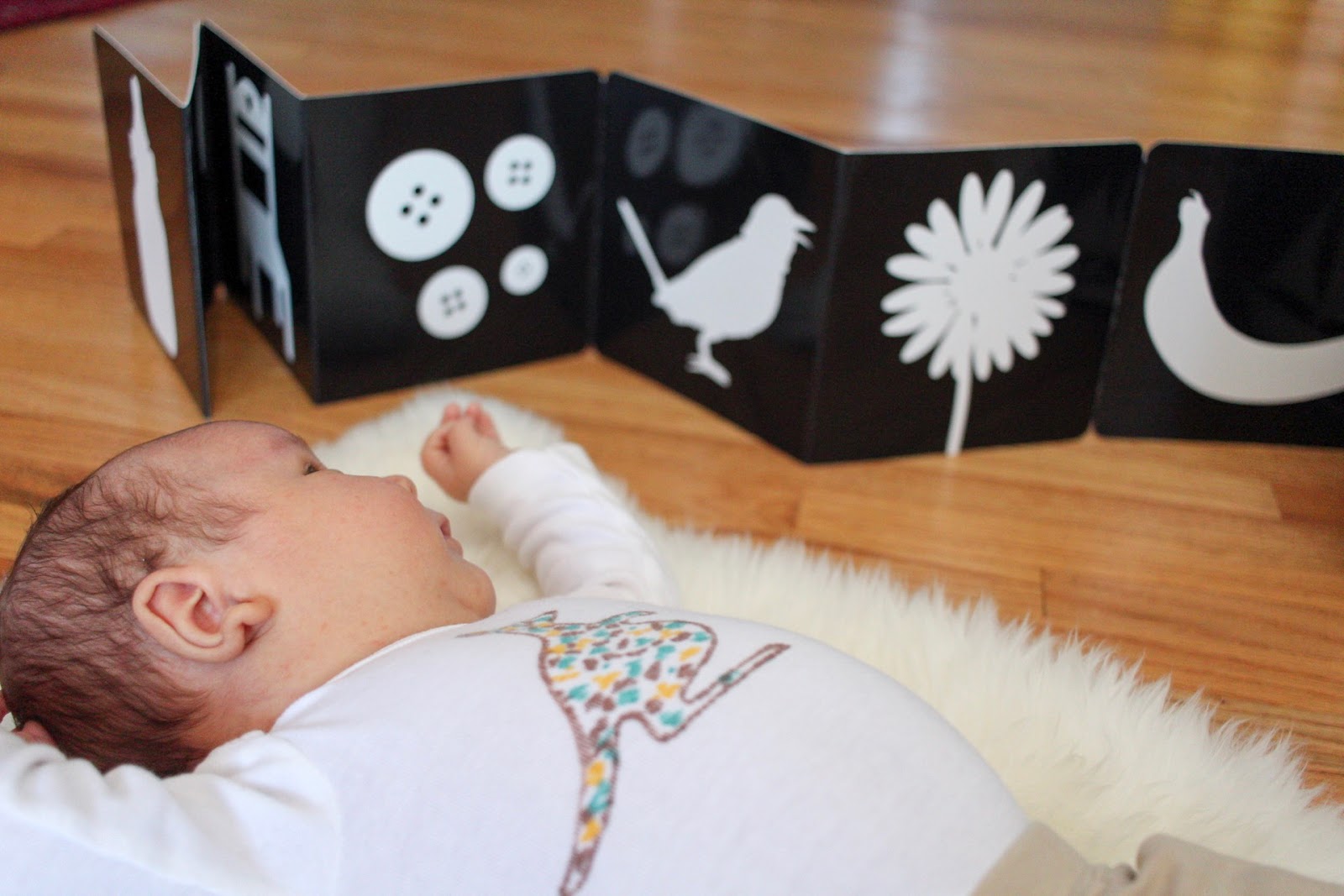From Blurry to Brilliant: Enhancing Newborn Vision with High-Contrast Cards

When a baby is born, its senses immediately begin collecting information. As they transition from the womb to the world, the baby's senses are focused on orientation and learning all about the world around the baby. The baby uses their sense of touch when placed upon their mother or caregiver. Some babies have even been observed crawling to their food source shortly after birth. Smell and taste are used to look for their mother's familiar scent and search for their food. They use hearing to orient themselves by listening to the familiar voices they hear in utero and the sound of their mother's heartbeat. The least developed of their senses is sight, so babies like to be held close; they can better see their caregivers' faces.
Newborn babies do not have pre-determined visual skills. When they are first born, their vision is very blurry. They are limited to only seeing objects or people relatively close to their faces (about 12-18 inches). This is because the nerve cells that control vision in the retina and brain have yet to develop fully. In the first few weeks of life, they only see things in black, white, and shades of gray. Over the ensuing few months, their vision will develop and improve. Despite their underdeveloped eyesight, it has been shown that babies prefer their mother's picture when given a choice between a photo of their mother or a stranger. This preference for familiar images can provide parents and caregivers with security and comfort. And that's just a few days after birth! While they may not be able to focus on the details of her face, researchers believe that the high contrast of the mother's hairline to her face is what the baby gains familiarity with and recognizes.
While their vision is not yet fully developed, their visual senses still provide a large amount of sensory input, so engaging this skill for optimal development is essential. You can use many things to stimulate your baby's visual senses and support their growth, from the Montessori Visual Mobiles to black-and-white high-contrast cards. Montessori environments and bedrooms are usually decorated with neutral colors to invoke a calming ambiance. Though this is important for their sense of order and the Absorbent Mind, a term in Montessori philosophy that refers to the child's ability to absorb information from their environment, it does not engage the visual senses of a newborn because their eyes can only see high contrast. Rather than changing the entire environment, you can employ materials specifically designed to support your baby's visual development.
Black and white high contrast cards are an incredible tool for newborns, offering a myriad of benefits. These cards, printed on thick paper like cardstock, usually feature shapes, animals, or other objects with high-contrast black-and-white imagery. They engage the baby's visual senses and provide the perfect amount of challenge without being overstimulating. In fact, young babies often show great focus with these images, a sight that can bring immense joy and satisfaction to parents and caregivers. The sharp lines and shapes draw and hold your baby's attention, providing optimal visual stimulation. It has been proven that they prefer looking at images with high-contrast black and white over those with less contrast. So not only is it a great choice for their development, but it is also one they'll enjoy, a sight that will bring a smile to your face.
High-contrast cards play a significant role in engaging elements of a baby's visual and cognitive development. These cards offer developmentally appropriate stimuli, which encourage focus and concentration. This creates a strong foundation for their mental development. The cards also encourage binocularity, or the two eyes working together, an important visual skill that will be needed when they begin learning to read. Staring at the high-contrast images strengthens the muscles in the babies' eyes and the neck and core. Offering the cards as a tool for your baby also encourages independent learning, which is an important pillar of Montessori philosophy. This empowerment and confidence in your baby's learning journey can fill parents and caregivers with a sense of accomplishment.
The high-contrast cards, which usually have a variety of images, allow them to connect with the shapes they see around them. During the Absorbent Mind (birth to age six), a term in Montessori philosophy that refers to the child's ability to absorb information from their environment, humans use everything they see and experience to form their thoughts and ideas about the world. Providing them with a strong foundation sets the tone for the rest of their lives. Many of the shapes shown in the black and white cards are your baby's first introduction to mathematical concepts and geometric shapes. While they may still need to understand these abstract concepts fully, the exposure is still a benefit. It will bolster their confidence when they are more formally introduced later in life.
You can use the black-and-white high-contrast cards for your baby in many ways. You can place them upright in their movement area to engage with while doing their work (remember, play is the child's work, and moving their body and observing is their work at this stage). You can also place the images in their changing area to give them something pleasing to look at while they are getting their diaper changed. They get changed so often as newborns; this will give them a lot of exposure to the images, but in shorter spurts since their attention spans are shorter. You can even frame some photos and place them around your baby's room at their eye level. Rather than having artwork high on the wall at adult height, you can hang their artwork low so they can easily see it without straining their neck. This placement offers them more passive than direct exposure by having the cards in their movement space.
These cards can be used from birth and will likely be enjoyed by your baby for many months. As they get older and become more familiar with the images on the card, you can work on labeling them and providing them with the language they are searching for. While black-and-white contrast cards may seem simple, they offer many benefits. They will surely be a source of engagement and concentration for your baby. The long-term benefits of using these cards, such as promoting visual and cognitive development, can reassure parents and caregivers about their baby's future and fill them with optimism.
Newborn babies do not have pre-determined visual skills. When they are first born, their vision is very blurry. They are limited to only seeing objects or people relatively close to their faces (about 12-18 inches). This is because the nerve cells that control vision in the retina and brain have yet to develop fully. In the first few weeks of life, they only see things in black, white, and shades of gray. Over the ensuing few months, their vision will develop and improve. Despite their underdeveloped eyesight, it has been shown that babies prefer their mother's picture when given a choice between a photo of their mother or a stranger. This preference for familiar images can provide parents and caregivers with security and comfort. And that's just a few days after birth! While they may not be able to focus on the details of her face, researchers believe that the high contrast of the mother's hairline to her face is what the baby gains familiarity with and recognizes.
While their vision is not yet fully developed, their visual senses still provide a large amount of sensory input, so engaging this skill for optimal development is essential. You can use many things to stimulate your baby's visual senses and support their growth, from the Montessori Visual Mobiles to black-and-white high-contrast cards. Montessori environments and bedrooms are usually decorated with neutral colors to invoke a calming ambiance. Though this is important for their sense of order and the Absorbent Mind, a term in Montessori philosophy that refers to the child's ability to absorb information from their environment, it does not engage the visual senses of a newborn because their eyes can only see high contrast. Rather than changing the entire environment, you can employ materials specifically designed to support your baby's visual development.
Black and white high contrast cards are an incredible tool for newborns, offering a myriad of benefits. These cards, printed on thick paper like cardstock, usually feature shapes, animals, or other objects with high-contrast black-and-white imagery. They engage the baby's visual senses and provide the perfect amount of challenge without being overstimulating. In fact, young babies often show great focus with these images, a sight that can bring immense joy and satisfaction to parents and caregivers. The sharp lines and shapes draw and hold your baby's attention, providing optimal visual stimulation. It has been proven that they prefer looking at images with high-contrast black and white over those with less contrast. So not only is it a great choice for their development, but it is also one they'll enjoy, a sight that will bring a smile to your face.
High-contrast cards play a significant role in engaging elements of a baby's visual and cognitive development. These cards offer developmentally appropriate stimuli, which encourage focus and concentration. This creates a strong foundation for their mental development. The cards also encourage binocularity, or the two eyes working together, an important visual skill that will be needed when they begin learning to read. Staring at the high-contrast images strengthens the muscles in the babies' eyes and the neck and core. Offering the cards as a tool for your baby also encourages independent learning, which is an important pillar of Montessori philosophy. This empowerment and confidence in your baby's learning journey can fill parents and caregivers with a sense of accomplishment.
The high-contrast cards, which usually have a variety of images, allow them to connect with the shapes they see around them. During the Absorbent Mind (birth to age six), a term in Montessori philosophy that refers to the child's ability to absorb information from their environment, humans use everything they see and experience to form their thoughts and ideas about the world. Providing them with a strong foundation sets the tone for the rest of their lives. Many of the shapes shown in the black and white cards are your baby's first introduction to mathematical concepts and geometric shapes. While they may still need to understand these abstract concepts fully, the exposure is still a benefit. It will bolster their confidence when they are more formally introduced later in life.
You can use the black-and-white high-contrast cards for your baby in many ways. You can place them upright in their movement area to engage with while doing their work (remember, play is the child's work, and moving their body and observing is their work at this stage). You can also place the images in their changing area to give them something pleasing to look at while they are getting their diaper changed. They get changed so often as newborns; this will give them a lot of exposure to the images, but in shorter spurts since their attention spans are shorter. You can even frame some photos and place them around your baby's room at their eye level. Rather than having artwork high on the wall at adult height, you can hang their artwork low so they can easily see it without straining their neck. This placement offers them more passive than direct exposure by having the cards in their movement space.
These cards can be used from birth and will likely be enjoyed by your baby for many months. As they get older and become more familiar with the images on the card, you can work on labeling them and providing them with the language they are searching for. While black-and-white contrast cards may seem simple, they offer many benefits. They will surely be a source of engagement and concentration for your baby. The long-term benefits of using these cards, such as promoting visual and cognitive development, can reassure parents and caregivers about their baby's future and fill them with optimism.








